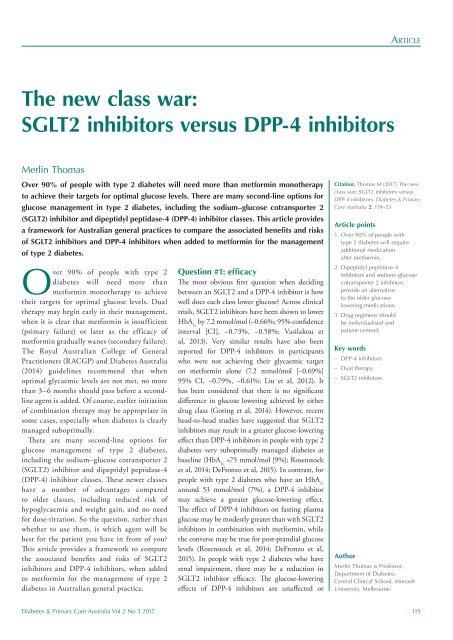DPCA 2-3_entire_v3
You also want an ePaper? Increase the reach of your titles
YUMPU automatically turns print PDFs into web optimized ePapers that Google loves.
Article<br />
The new class war:<br />
SGLT2 inhibitors versus DPP-4 inhibitors<br />
Merlin Thomas<br />
Over 90% of people with type 2 diabetes will need more than metformin monotherapy<br />
to achieve their targets for optimal glucose levels. There are many second-line options for<br />
glucose management in type 2 diabetes, including the sodium–glucose cotransporter 2<br />
(SGLT2) inhibitor and dipeptidyl peptidase-4 (DPP-4) inhibitor classes. This article provides<br />
a framework for Australian general practices to compare the associated benefits and risks<br />
of SGLT2 inhibitors and DPP-4 inhibitors when added to metformin for the management<br />
of type 2 diabetes.<br />
Over 90% of people with type 2<br />
diabetes will need more than<br />
metformin monotherapy to achieve<br />
their targets for optimal glucose levels. Dual<br />
therapy may begin early in their management,<br />
when it is clear that metformin is insufficient<br />
(primary failure) or later as the efficacy of<br />
metformin gradually wanes (secondary failure).<br />
The Royal Australian College of General<br />
Practitioners (RACGP) and Diabetes Australia<br />
(2014) guidelines recommend that when<br />
optimal glycaemic levels are not met, no more<br />
than 3–6 months should pass before a secondline<br />
agent is added. Of course, earlier initiation<br />
of combination therapy may be appropriate in<br />
some cases, especially when diabetes is clearly<br />
managed suboptimally.<br />
There are many second-line options for<br />
glucose management of type 2 diabetes,<br />
including the sodium–glucose cotransporter 2<br />
(SGLT2) inhibitor and dipeptidyl peptidase-4<br />
(DPP-4) inhibitor classes. These newer classes<br />
have a number of advantages compared<br />
to older classes, including reduced risk of<br />
hypoglycaemia and weight gain, and no need<br />
for dose-titration. So the question, rather than<br />
whether to use them, is which agent will be<br />
best for the patient you have in front of you?<br />
This article provides a framework to compare<br />
the associated benefits and risks of SGLT2<br />
inhibitors and DPP-4 inhibitors, when added<br />
to metformin for the management of type 2<br />
diabetes in Australian general practice.<br />
Question #1: efficacy<br />
The most obvious first question when deciding<br />
between an SGLT2 and a DPP-4 inhibitor is how<br />
well does each class lower glucose? Across clinical<br />
trials, SGLT2 inhibitors have been shown to lower<br />
HbA 1c<br />
by 7.2 mmol/mol (−0.66%; 95% confidence<br />
interval [CI], −0.73%, −0.58%; Vasilakou et<br />
al, 2013). Very similar results have also been<br />
reported for DPP-4 inhibitors in participants<br />
who were not achieving their glycaemic target<br />
on metformin alone (7.2 mmol/mol [−0.69%]<br />
95% CI, −0.79%, −0.61%; Liu et al, 2012). It<br />
has been considered that there is no significant<br />
difference in glucose lowering achieved by either<br />
drug class (Goring et al, 2014). However, recent<br />
head-to-head studies have suggested that SGLT2<br />
inhibitors may result in a greater glucose-lowering<br />
effect than DPP-4 inhibitors in people with type 2<br />
diabetes very suboptimally managed diabetes at<br />
baseline (HbA 1c<br />
>75 mmol/mol [9%]; Rosenstock<br />
et al, 2014; DeFronzo et al, 2015). In contrast, for<br />
people with type 2 diabetes who have an HbA 1c<br />
around 53 mmol/mol (7%), a DPP-4 inhibitor<br />
may achieve a greater glucose-lowering effect.<br />
The effect of DPP-4 inhibitors on fasting plasma<br />
glucose may be modestly greater than with SGLT2<br />
inhibitors in combination with metformin, while<br />
the converse may be true for post-prandial glucose<br />
levels (Rosenstock et al, 2014; DeFronzo et al,<br />
2015). In people with type 2 diabetes who have<br />
renal impairment, there may be a reduction in<br />
SGLT2 inhibitor efficacy. The glucose-lowering<br />
effects of DPP-4 inhibitors are unaffected or<br />
Citation: Thomas M (2017) The new<br />
class war: SGLT2 inhibitors versus<br />
DPP-4 inhibitors. Diabetes & Primary<br />
Care Australia 2: 119–23<br />
Article points<br />
1. Over 90% of people with<br />
type 2 diabetes will require<br />
additional medication<br />
after metformin.<br />
2. Dipeptidyl peptidase-4<br />
inhibitors and sodium–glucose<br />
cotransporter 2 inhibitors<br />
provide an alternative<br />
to the older glucoselowering<br />
medications.<br />
3. Drug regimens should<br />
be individualised and<br />
patient-centred.<br />
Key words<br />
– DPP-4 inhibitors<br />
– Dual therapy<br />
– SGLT2 inhibitors<br />
Author<br />
Merlin Thomas is Professor,<br />
Department of Diabetes,<br />
Central Clinical School, Monash<br />
University, Melbourne.<br />
Diabetes & Primary Care Australia Vol 2 No 3 2017 119
















